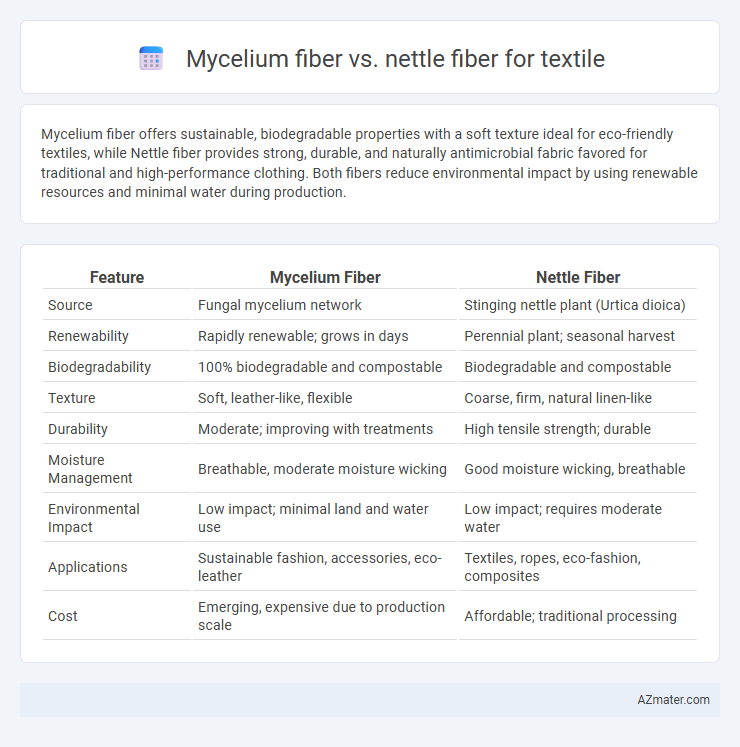Mycelium fiber offers sustainable, biodegradable properties with a soft texture ideal for eco-friendly textiles, while Nettle fiber provides strong, durable, and naturally antimicrobial fabric favored for traditional and high-performance clothing. Both fibers reduce environmental impact by using renewable resources and minimal water during production.
Table of Comparison
| Feature | Mycelium Fiber | Nettle Fiber |
|---|---|---|
| Source | Fungal mycelium network | Stinging nettle plant (Urtica dioica) |
| Renewability | Rapidly renewable; grows in days | Perennial plant; seasonal harvest |
| Biodegradability | 100% biodegradable and compostable | Biodegradable and compostable |
| Texture | Soft, leather-like, flexible | Coarse, firm, natural linen-like |
| Durability | Moderate; improving with treatments | High tensile strength; durable |
| Moisture Management | Breathable, moderate moisture wicking | Good moisture wicking, breathable |
| Environmental Impact | Low impact; minimal land and water use | Low impact; requires moderate water |
| Applications | Sustainable fashion, accessories, eco-leather | Textiles, ropes, eco-fashion, composites |
| Cost | Emerging, expensive due to production scale | Affordable; traditional processing |
Introduction to Mycelium and Nettle Fibers
Mycelium fiber, derived from the root structure of fungi, offers a sustainable and biodegradable alternative for textile production, characterized by its lightweight and durable properties. Nettle fiber, sourced from the stems of the Urtica dioica plant, is valued for its natural strength, breathability, and eco-friendly cultivation process without the need for pesticides. Both fibers present innovative opportunities for sustainable textiles, with mycelium emphasizing biodegradability and nettle focusing on renewable agricultural sources.
Historical Background of Mycelium and Nettle Textiles
Mycelium fiber, derived from fungal mycelium, has emerged as a sustainable textile alternative with roots in ancient fungal uses for medicinal and functional purposes, whereas nettle fiber boasts a documented history dating back to prehistoric times when indigenous communities in Europe and Asia utilized its strong, durable fibers for clothing and rope. Archaeological evidence reveals that nettle textiles were prominent in Northern Europe during the Bronze and Iron Ages, highlighting its longstanding role in handcrafted fabric production. Mycelium textiles, while more contemporary in industrial application, draw on traditional knowledge of fungi's structural properties, showcasing a fusion of ancient biological insight and modern material innovation.
Sourcing and Cultivation Processes
Mycelium fiber is sourced from the root structure of fungi and cultivated through controlled fermentation processes that require minimal land and water usage, making it highly sustainable. Nettle fiber comes from the stalks of the stinging nettle plant, which thrives in natural soils and regenerates quickly with low pesticide input, emphasizing eco-friendly agricultural practices. Both fibers offer renewable sourcing options, but mycelium's microbial cultivation contrasts with nettle's traditional plant farming methods, influencing their respective scalability and environmental footprints.
Environmental Impact and Sustainability
Mycelium fiber, derived from fungal mycelium, offers a biodegradable and low-energy alternative to traditional textiles, significantly reducing environmental impact through minimal water usage and natural decomposition. Nettle fiber, harvested from the Urtica dioica plant, supports sustainable agriculture by requiring no pesticides or synthetic fertilizers and promoting biodiversity while providing durable, breathable fabric. Both fibers contribute to sustainability, with mycelium excelling in rapid renewability and nettle enhancing soil health and carbon sequestration during cultivation.
Physical Properties and Durability
Mycelium fiber exhibits lightweight and flexible characteristics with moderate tensile strength, making it suitable for sustainable textile applications where biodegradability is prioritized. Nettle fiber offers higher tensile strength and excellent durability due to its long bast fibers, providing resistance to wear and tear in garment production. Both fibers are breathable and biodegradable, but nettle fiber generally outperforms mycelium fiber in mechanical resilience and longevity in textiles.
Texture, Feel, and Comfort
Mycelium fiber offers a smooth, supple texture with natural breathability, making it ideal for lightweight, comfortable textiles. Nettle fiber provides a coarser, slightly rougher feel but gains softness with processing, delivering durable and moisture-wicking fabrics. Both fibers excel in eco-friendly textile production, with mycelium emphasizing softness and nettle enhancing strength and comfort.
Dyeing and Customization Capabilities
Mycelium fiber offers excellent dye absorption and allows for vibrant, uniform coloration due to its porous structure, enhancing customization options for textile design. Nettle fiber, characterized by its natural stiffness, responds well to natural dyes and produces earthy, muted tones that appeal to eco-conscious consumers seeking organic aesthetics. Both fibers provide sustainable alternatives with unique dyeing properties, but mycelium excels in achieving brighter hues while nettle supports understated, natural dye palettes.
Applications in Modern Fashion
Mycelium fiber offers sustainable advantages in modern fashion with its biodegradable properties and versatility for creating leather-like materials suited for eco-friendly accessories and footwear. Nettle fiber, known for its durability and natural moisture-wicking ability, is increasingly utilized in high-performance and sustainable garment production, particularly in outerwear and casual wear. Both fibers represent innovative alternatives to conventional textiles, enhancing ethical fashion with their unique textures and environmental benefits.
Economic Viability and Market Trends
Mycelium fiber offers a rapidly renewable and biodegradable alternative with growing investment from sustainable fashion brands, presenting strong potential for economic viability as production scales and costs decrease. Nettle fiber, with its long history of use and established harvesting practices, benefits from a stable market presence and lower raw material costs but faces challenges in large-scale modernization and competition from synthetic fibers. Market trends indicate increasing consumer demand for eco-friendly textiles, positioning both fibers as promising options, yet Mycelium's innovation-driven appeal attracts higher premium pricing and venture capital interest in the textiles sector.
Future Prospects in Sustainable Textiles
Mycelium fiber offers revolutionary potential for sustainable textiles due to its biodegradability, rapid growth, and minimal resource requirements, positioning it as a future-forward alternative to conventional fibers. Nettle fiber, with its long history of use and natural durability, provides an eco-friendly option that requires less water and pesticides compared to cotton, making it attractive for sustainable fabric production. Both fibers contribute to reducing the environmental impact of the fashion industry through renewable sourcing and lower chemical inputs, indicating strong future prospects in eco-conscious textile innovation.

Infographic: Mycelium fiber vs Nettle fiber for Textile
 azmater.com
azmater.com